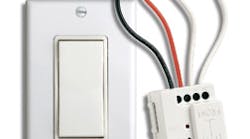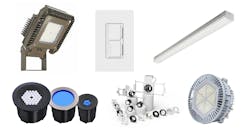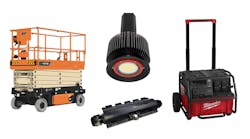A unique battery-free, wireless technology sweeping through Europe is garnering interest among American electrical contractors — and for good reason. Battery-free, wireless switches make installing light switches simple for electricians and save money for home and business owners.
First developed in Europe five years ago by German company EnOcean GmbH, battery-free, wireless switches were brought to North America about a year ago by wireless solutions provider Ad Hoc Electronics, Orem, Utah. Although wireless switches have been around for years, they always required batteries. According to Jan Finlinson, director of Ad Hoc Electronics, its wireless switch uses energy harvesting technology — the process in which unusual sources of energy such as solar or wind power are captured and used to facilitate operation — in place of batteries.
With energy harvesting technology, the method for installing and using a battery-free, wireless switch is relatively simple. The basic system is made up of a one-channel relay receiver and a switch. The receiver is easily installed by connecting a few wires to the load. “The receiver module is installed at the light fixture and is wired from the panel to the fixture,” Finlinson says.
The switch is then mounted with adhesive or screws. The inside of the switch houses a module and magnetic coil. Pressing the rocker creates mechanical energy that transmits out a radio signal to the receiver, telling it to turn the light on or off. “The transmitters do not store energy,” Finlinson says. “The press of the switch itself creates the energy.”
Programming the light to connect with the switch is done through a simple ID learn sequence in which a learn button on the receiver is pressed, causing the light to go into a learn mode. The switch is then assigned to the receiver by pressing the rocker. To exit the learn mode, the learn button is pressed again, and the switch now works with the light — a process similar to syncing up a garage door opener.
Battery-free, wireless switches can communicate with an unlimited amount of receivers, and every receiver can respond to up to 30 switches. Three- and four-way switches also can be created with the system. The switches have about a 50- to 150-foot range, depending on obstructions, and a repeater module can be added to increase the range another 50 to 150 feet. Using multiple repeaters, one switch can be used to control an entire building. According to Finlinson, it costs about $120 to control one light — $60 for a switch and $60 for a receiver.
Switches are available in various colors and styles, such as the sleek, modern European switch in black or white single- or dual-rocker models, or white decorator switches in one-, two-, or three-gang models. A handheld, dual-rocker remote control in black, white, or silver also is available.
Commercial remodeling and log home building are two areas showing battery-free, wireless switches some attention. Remodelers like to use the battery-free, wireless switch when they have to install additional switches, Finlinson says, such as when outdoor floodlights are added to the back of a house. Other times, homeowners may want to move switches located behind a piece of furniture or install a new switch in a new location. “Without the battery-free, wireless switch, the electrician would have to break through the sheetrock and redo a portion of the wall,” Finlinson says.
Finlinson notes that members of his local IEC are “going gangbusters” for the battery-free, wireless switches. Electrical contractor Dirk Burton of Able Electric Co., West Jordan, Utah, can attest to its simple use after having installed battery-free, wireless switches a handful of times since learning about the device at an IEC trade show. “I've used it in a bedroom where recessed can lights had been installed in vaulted ceilings,” Burton says. “The homeowners wanted a switch near the bed.”
He's also used it when installing an exhaust fan in a bathroom and in an application where a homeowner wanted to control a post light in the front yard from a second-story deck. “It's easy to use, and the programs were super easy to install,” says Burton, adding that he saved time and the customer saved money in wall repairs because no patching or painting was required.
While interest for the battery-free, wireless switch continues to grow, electrical contractors like Burton will benefit from the switch's simple installation and decreased labor time and costs. For more information, visit www.adhocelectronics.com.
Product Features
- 50- to 150-ft transmission range indoors
- Up to 30 switches can control one load.
- One switch controls an unlimited number of light modules.
- Mounts with adhesive or screws; requires no switch box or wires.
- MSRP: $120 per system — $60 for the switch, $60 for the receiver
Upon Further Review
The January 2007 “Product of the Month” story, “Wireless Switch Sheds Reliance on Battery Power,” featured a “unique” battery-free, wireless technology product offered by Ad Hoc Electronics. Upon further review; however, we discovered the item isn’t as unique as we first thought. There’s another battery-free, wireless switch manufacturer operating in the states. PulseSwitch Systems of Norfolk, Va., has been selling its patented Lightning Switch wireless and battery-less switch controls in North America since 2004.
For more information, visit www.lightningswitch.com.
EC&M editorial team



